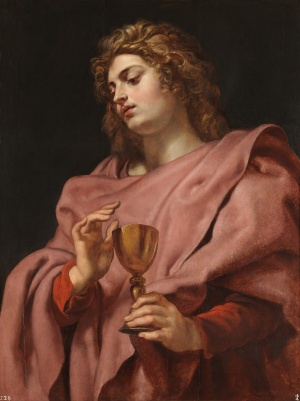John: Difference between revisions
mNo edit summary |
No edit summary |
||
| Line 1: | Line 1: | ||
[[File:Johannes-Ruebens.jpg|right|px250|thumb|Ruben's painting of the beloved disciple. The Gospel of John is a uniquely written scripture from the "Johannine" society.]] | |||
The Gospel According to John (also referred to as the Gospel of John, the Fourth Gospel, or simply John. The Gospel of John was written in Greek by an anonymous author. The gospel identifies its author as "the disciple whom Jesus loved." Although the text does not name this disciple, by the beginning of the 2nd century, a tradition had begun to form which identified him with John the Apostle, one of the Twelve. | The Gospel According to John (also referred to as the Gospel of John, the Fourth Gospel, or simply John. The Gospel of John was written in Greek by an anonymous author. The gospel identifies its author as "the disciple whom Jesus loved." Although the text does not name this disciple, by the beginning of the 2nd century, a tradition had begun to form which identified him with John the Apostle, one of the Twelve. | ||
Revision as of 08:04, 2 June 2023

The Gospel According to John (also referred to as the Gospel of John, the Fourth Gospel, or simply John. The Gospel of John was written in Greek by an anonymous author. The gospel identifies its author as "the disciple whom Jesus loved." Although the text does not name this disciple, by the beginning of the 2nd century, a tradition had begun to form which identified him with John the Apostle, one of the Twelve.
Some notable New Testament scholars affirm another tradition. They trace it instead to a "Johannine community" which traced its traditions to John; the gospel itself shows signs of having been composed in three "layers", reaching its final form about 90–100 AD.
The gospel contains more direct claims to eyewitness origins than any of the other Gospel traditions.
John
John 1 | John 2 | John 3 | John 4 | John 5 |
John 6 | John 7 | John 8 | John 9 | John 10 |
John 11 | John 12 | John 13 | John 14 |
John 15 | John 16 | John 17 | John 18 |
John 19 | John 20 | John 21 | Bible
Bible |
Bible Index |
Bible References |
Biblical bunch |
Sophistry |
Modern Christians |
Whosoever believeth |
Religion |
Bible_terms |
Early non Bible authors
Athenagoras of Athens | Methodius of Olympus | Theophilus or Ignatius of Antioch
Hippolytus of Rome | Justin the Martyr | Jerome | Augustine of Hippo |
Epistle of Mathetes | Gospel of James | The Gospel of Thomas |
Philo Judaeus or Philo of Alexandria and The Allegories of the Sacred Laws
Polybius | Plutarch | Seneca | Tacitus | Suetonius |
Marcus Tullius Cicero | Celsus | Diotrephes |
People in the Bible
Paul the Apostle |
Melchizedek |
Moses |
Cain |
Caesar |
Herod |
Jesus |
John the Baptist |
Matthew |
Mark |
Luke |
John |
Nimrod |
Abraham |
Essenes |
Pharisees |
Sadducees |
Zealots |
Julius Caesar | Augustus Caesar | Tiberius | Nero |
Historical People
Buddha |
Constantine |
Eusebius |
Ambrose |
Augustine of Canterbury |
Lady Godiva |
Vespian |
Diocletian |
Manichaeism |
John Wycliffe |